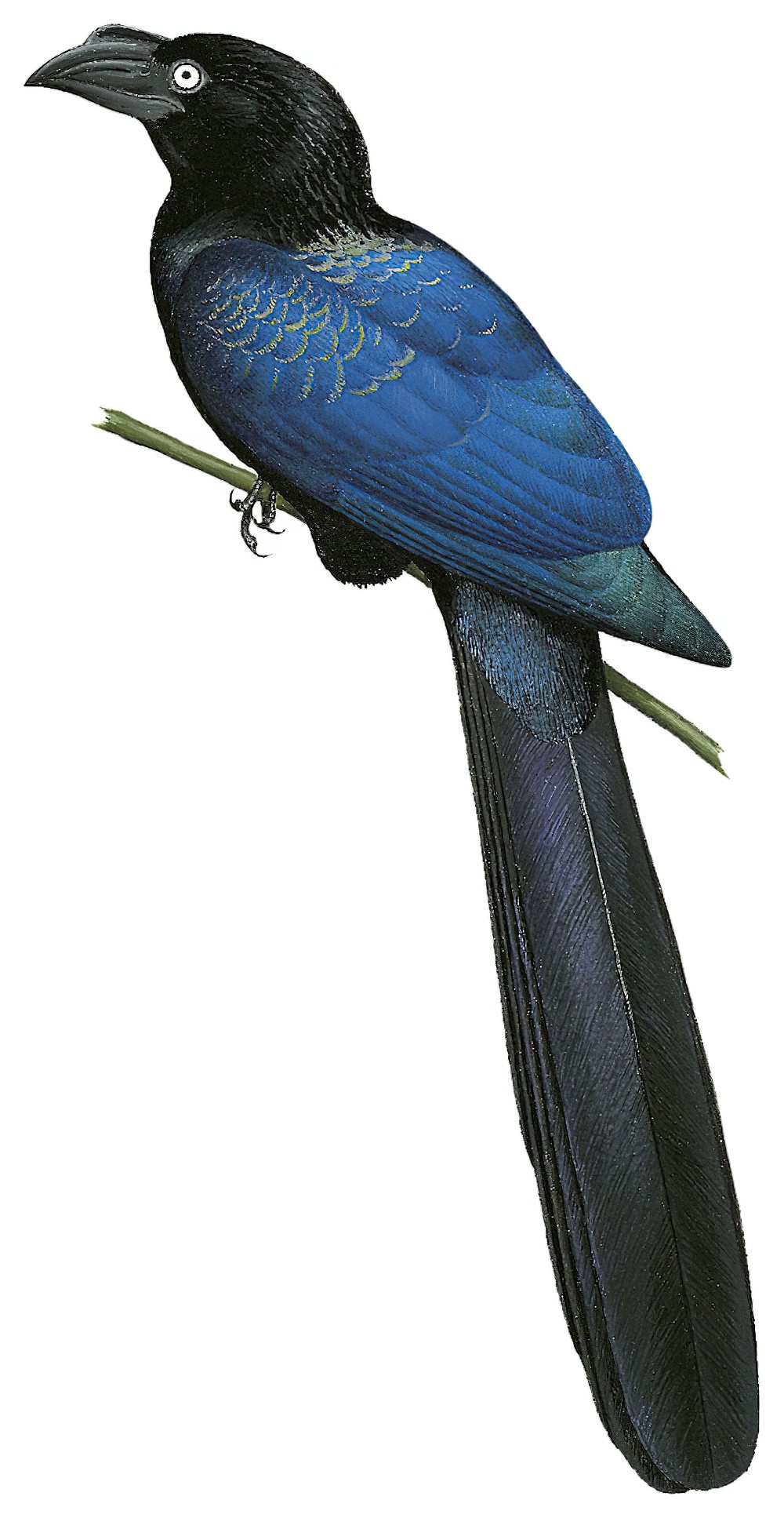Greater Ani / Crotophaga major

Greater Ani
SCI Name:
Protonym: Crotophaga major Syst.Nat. 1 pt1 p.363
Taxonomy: Cuculiformes / Cuculidae / Crotophaga
Taxonomy Code: greani1
Type Locality: Cayenne.
Author: Gmelin, JF
Publish Year: 1788
IUCN Status: Least Concern
DEFINITIONS
CROTOPHAGA
(Cuculidae; Ϯ Smooth-billed Ani C. ani) Gr. κροτων krotōn, κροτωνος krotōnos tick; -φαγος -phagos -eating < φαγειν phagein to eat; “They live chiefly upon ticks and other small vermin” (P. Browne 1769); “Crotophagus of Linnaeus and Brisson ... because this genus feeds on ticks ... I retain the Brasilian name Ani” (Pennant 1773) (pace Payne in del Hoyo et al. (eds.) 1998, “Anis often have a strong smell ... Their generic name Crotophaga means eater of “croton oil”, which is the oil of the East Indian croton tree (Croton tiglium) and is a foul-smelling medicinal purgative”); "47. CROTOPHAGA. Rostrum compressum, semiovatum, arcuatum, sulco utrinque exaratum; Mandibula superiore margine utrinque angulata. Nares perviæ." (Linnaeus 1758); "Crotophaga Linné, Syst. Nat., ed. 10, 1, 1758, p. 105. Type, by monotypy, Crotophaga ani Linné." (Peters, 1940, IV, p. 57). This is the eighth diagnosed genus in avian taxonomy. Linnaeus's Crotophaga comprised only one species.
Var. Crotophagus, Cratophaga.
crotophaga / crotophagus
Gr. κροτων krotōn, κροτωνος krotōnos tick; -φαγος -phagos -eating < φαγειν phagein to eat.
● ex “Chimachima” of de Azara 1802-1805, no. 6 (syn. Milvago chimachima).
major
L. maior, maioris greater, larger < comp. magnus great, large, powerful.
● ex “Poule d’eau de Cayenne” of d’Aubenton 1765-1781, pl. 352; “Even if [Statius Müller, 1776] ...should some day be repudiated by ornithologists on account of his carelessness and his apparent colour-blindness, then the proper name of the species would be Aramides major (Boddaert), founded on Daubenton’s plate” (Sharpe 1894) (syn. Aramides cajanea).
● ex “Grand Corbeau” of Levaillant 1800, pl. 51 (unident.;?Corvus sp.).
● ex “Crotophagus major” of Brisson 1760, “Grand bout de Petun” of d’Aubenton 1765-1781, pl. 102, fig. 1, “Ani des palétuviers” of Salerne 1767, and “Greater Ani” of Latham 1781 (Crotophaga).
● 54. PICUS. ... major. 10. P. albo nigroque varius, ano occipiteque rubro. Picus albo nigroque varius, rectricibus tribus lateralibus utrinque albescentibus. Fn. svec. 81. Picus varius major. Ges. av. 708. Aldr. ornith. l. 12. c. 32. Will. orn. 94. t. 21. Raj. av. 43. Alb. av. I. p. 19. t. 19. Frisch. av. . . t. 36. f. 1. Habitat in Europa." (Linnaeus 1758) (Dendrocopos).
● ex “Grande Egrette d’Amérique” of d’Aubenton, 1765-1781, pl. 925 (syn. Egretta garzetta).
● ex “Scolopax media” of Frisch 1733-1763, “Great Snipe” of Pennant 1768, and Latham 1785 (syn. Gallinago media).
● ex “Grand Indicateur, mâle” of Levaillant 1807, pl. 241, fig. 1 (syn. Indicator indicator).
● ex “Pie-grièche Blanchot” of Levaillant 1810, pl. 285 (syn. Malaconotus blanchoti).
● ex “An other sort of Loggerhead” of Sloane 1707-1725, “Sitta” or “Picus cinereus major, rostro curvo” of Ray 1713, “Grand Sittelle à bec crochu” of de Buffon 1770-1783, and “Great Nuthatch” of Latham 1781 (?syn. Myiarchus validus).
● ex “Parus major” of Gessner 1555, Belon 1555, Aldrovandus 1599, and Willughby 1676, “Fringillago”, “Great Titmouse” or “Ox Eye” of Ray 1713, and Albin 1731, and “Parus capite nigro, temporibus albis, nucha luteis” of Linnaeus 1746 (Parus).
● ex “Grèbe de Cayenne” of d’Aubenton 1765-1781, pl. 404, fig. 1, and “Grand Grèbe” of de Buffon 1770-1785 (Podiceps).
● ex “Barbican des côtes de Barbarie” of d’Aubenton 1765-1781, pl. 602 (syn. Pogonornis dubius).
● ex “Grande Quiscale” of Vieillot 1819 (Quiscalus).
● ex “Tangara des grands bois de Cayenne” of d’Aubenton 1765-1781, pl. 205 (syn. Saltator maximus).
● ex “Batara mayor” of de Azara 1802-1805, no. 211 (Taraba).
● ex “Macucagua” of Marcgrave 1648, Willughby 1676, and Ray 1713, “Perdix brasiliensis” of Brisson 1760, and “Magoua” of de Buffon 1770-1783 (Tinamus).
● ex “Trepadore grande” of de Azara 1802-1805, no. 241 (Xiphocolaptes).
UPPERCASE: current genus
Uppercase first letter: generic synonym
● and ● See: generic homonyms
lowercase: species and subspecies
●: early names, variants, mispellings
‡: extinct
†: type species
Gr.: ancient Greek
L.: Latin
<: derived from
syn: synonym of
/: separates historical and modern geographic names
ex: based on
TL: type locality
OD: original diagnosis (genus) or original description (species)












